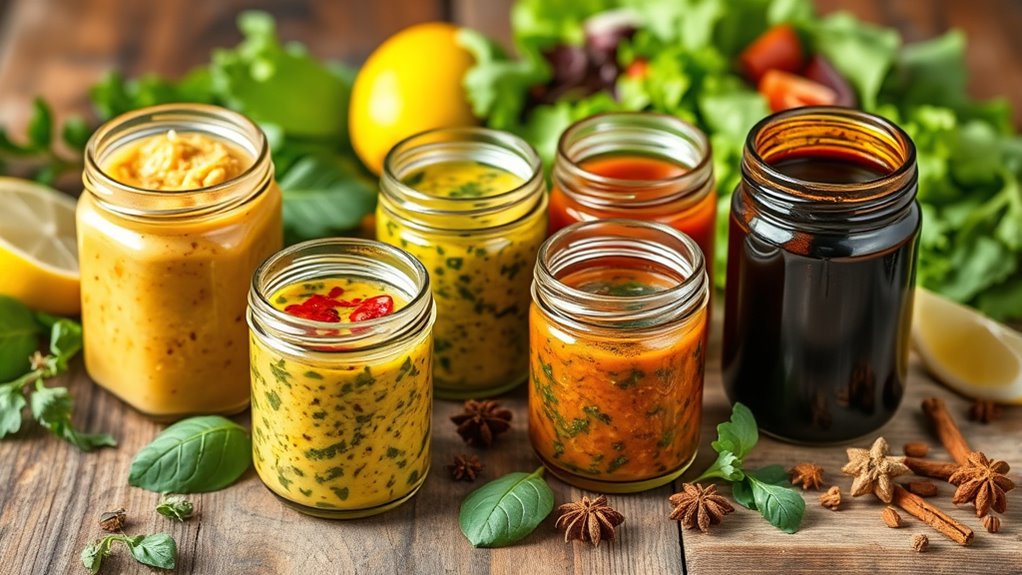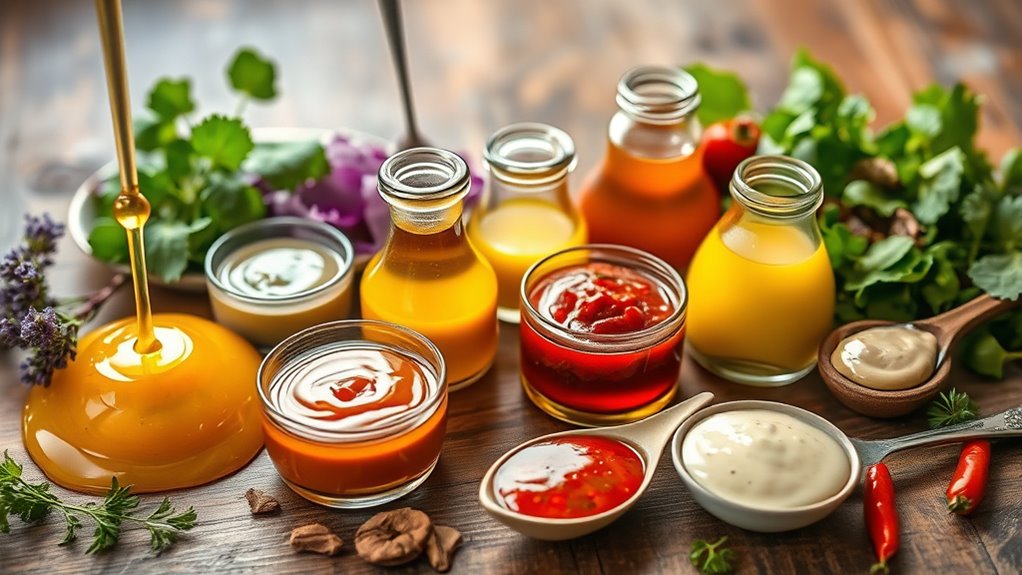Explore how regional cuisines influence salad dressings worldwide. From the French vinaigrette’s bright, tangy flavors to Japanese sesame dressings with nutty umami, each reflects local ingredients and traditions. Latin dressings bring citrus and chili zest, while Middle Eastern tahini adds richness. By understanding these diverse flavors, you can elevate your salads to global tastes. Keep discovering how these culinary influences can inspire your next salad creation.
Key Takeaways
- Regional dressings incorporate local ingredients, spices, and culinary traditions to create authentic flavor profiles.
- European-inspired dressings like French vinaigrette emphasize balance, acidity, and elegance.
- Asian dressings use nutty, umami-rich ingredients such as sesame and soy for depth.
- Latin American flavors highlight citrus, herbs, and spices like lime, cilantro, and chili for vibrant heat.
- Mediterranean dressings feature creamy, citrusy elements with ingredients like tahini, garlic, and lemon, reflecting regional tastes.

Salad dressings offer a delicious way to bring global flavors to your plate. They’re more than just condiments; they’re a journey through different cultures and culinary traditions. When you choose a dressing inspired by a specific region, you’re not only adding flavor but also connecting with the history and ingredients unique to that place.
Whether you’re drizzling a tangy vinaigrette or creamy dressing, understanding the roots of these flavors can elevate your salads from simple greens to a culinary adventure.
Understanding the origins of dressings elevates salads into flavorful journeys around the world.
Imagine starting with a classic French vinaigrette. You combine Dijon mustard, red wine vinegar, olive oil, and a pinch of shallots for a bright, tangy dressing that embodies French elegance. Its balanced acidity pairs perfectly with bitter greens or roasted vegetables, making every bite feel refined.
Moving east, you might explore the vibrant flavors of a Japanese sesame dressing. Made with tahini or ground sesame seeds, soy sauce, rice vinegar, and a touch of honey, it offers a nutty, savory profile that complements crisp lettuce or shredded carrots. This dressing reflects Japan’s love for umami and subtle sweetness, adding depth to your salads.
If you’re craving something bold, consider Mexican-inspired flavors. A zesty lime and cilantro dressing, often infused with chili powder or cumin, can give your greens a burst of heat and zest. It mirrors the lively, spicy nature of Mexican cuisine, perfect for pairing with grilled chicken or avocado slices.
For those who enjoy Middle Eastern tastes, a creamy tahini dressing seasoned with lemon juice, garlic, and a dash of cumin offers a nutty, citrusy richness. It’s ideal over salads with roasted chickpeas or grilled vegetables, bringing a touch of the Mediterranean to your table.
Latin American influences bring bright, citrusy, and herbal elements. A cilantro-lime dressing with a hint of jalapeño provides an invigorating kick, echoing flavors found in many Latin dishes. It’s particularly delightful on salads with corn, black beans, or grilled seafood.
Each regional dressing offers a unique combination of ingredients, reflecting the local produce, spices, and culinary philosophies. By experimenting with these diverse flavors, you can transform a simple salad into a reflection of the world’s rich culinary tapestry. Additionally, exploring healthy cooking techniques such as using fresh ingredients and mindful seasoning can enhance the nutritional value of your salads while respecting regional culinary traditions.
Frequently Asked Questions
How Do Regional Ingredients Influence Salad Dressing Flavors?
Regional ingredients play a big role in shaping salad dressing flavors. When you use local herbs, spices, or oils, you infuse your dressings with unique tastes that reflect the area’s culinary traditions.
For example, citrus from the Mediterranean can brighten a dressing, while chili peppers from Asia add heat. By incorporating these regional ingredients, you create dressings that are vibrant, authentic, and deeply connected to their origins.
What Are Common Dietary Adaptations for Regional Salad Dressings?
Think of regional salad dressings as a tapestry woven with local ingredients. You might swap dairy for plant-based alternatives or reduce sugar to cater to health needs.
Using olive oil instead of heavy mayo or adding herbs instead of salt keeps flavors authentic while fitting your dietary needs. These adaptations help you enjoy vibrant, region-inspired dressings without compromising your health, making every salad a personalized masterpiece.
How Can I Create Fusion Salad Dressings Combining Different Regional Tastes?
To create fusion salad dressings, start by blending flavors from different regions that complement each other.
You might combine a tangy balsamic with spicy Sriracha or mix creamy yogurt with fragrant lemongrass.
Experiment with herbs, spices, and acids to balance the flavors.
Taste as you go, adjusting sweetness, acidity, and heat.
This approach lets you craft unique dressings that reflect diverse culinary traditions and delight your palate.
What Historical Factors Shaped Regional Salad Dressing Preferences?
History heavily influences your regional salad dressing preferences. Trade routes, cultural exchanges, and colonial conquests introduced distinct ingredients and techniques, shaping local tastes.
For example, Mediterranean dressings often feature olive oil, reflecting ancient trade, while Asian flavors incorporate soy and sesame, influenced by centuries of cultural contact.
Understanding these historical factors helps you appreciate why certain flavors dominate your region and inspires you to blend diverse tastes creatively.
Are There Traditional Methods for Preparing Regional Salad Dressings?
You can find traditional methods for preparing regional salad dressings by exploring local ingredients and techniques. For example, in the Mediterranean, you might whisk olive oil with lemon juice and herbs.
In Asia, soy sauce, sesame oil, and rice vinegar are common. Many regions use mortar and pestle to blend ingredients, ensuring fresh flavors.
Embracing these methods helps you create authentic dressings that highlight regional culinary heritage.
Conclusion
As you drizzle a tangy balsamic vinaigrette or scoop up creamy tahini, you’re tasting a world of flavors. Imagine the sun-kissed orchards of Italy or the bustling spice markets of Morocco, all captured in each bite. With every salad you make, you’re not just adding dressing—you’re weaving a vibrant tapestry of culture and tradition. So, embrace these flavors and turn your salad into a colorful, delicious journey around the globe.









